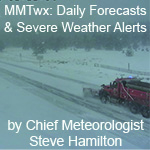- Posts: 15745
- Thank you received: 320
Science Odds and Ends
- ScienceChic
-
 Topic Author
Topic Author
- Mountain Champion
-

"Now, more than ever, the illusions of division threaten our very existence. We all know the truth: more connects us than separates us. But in times of crisis the wise build bridges, while the foolish build barriers. We must find a way to look after one another as if we were one single tribe.” -King T'Challa, Black Panther
The truth is incontrovertible. Malice may attack it. ignorance may deride it, but in the end, there it is. ~Winston Churchill
Please Log in or Create an account to join the conversation.
- TPP
-

- User is blocked
-

- Posts: 4760
- Thank you received: 0
Please Log in or Create an account to join the conversation.
- TPP
-

- User is blocked
-

- Posts: 4760
- Thank you received: 0
This is a pay-for view site, so I'll look for more info on it...
Ten M-Class Flares Over Last 48 Hours - X-Class to Follow
Over the last 48 hours, ten (10) M-Class flares have fired off from at least three separate sunspot regions. Space Shuttle was put on alert and lands safely prior to elevated solar activity.
Mar 9, 2011 - 1:26:05 PM
http://earthchangesmedia.com/
Japan gets hit with a 7.1 earthquake, then 3 6+ "aftershocks"... hmmmmm!
NOAA Says Powerful X-Class Solar Flare Will Hit Over Next 72 Hours; Communications Systems Vulnerable
Posted on 18/02/2011 by Mario
The NOAA Space Weather Prediction Center is advising that a powerful X-class solar flare is on its way to Earth. Charged plasma particles are expected to reach earth today.
China has already begun experiencing effects from a coronal mass ejection that preceded the X-class flare by a couple days:
The China Meteorological Administration reported that the solar flare had jammed shortwave radio communications in southern China.
It said the flare caused “sudden ionospheric disturbances” in the atmosphere above China, and warned there was a high probability that large solar flares would appear over the next three days, the official Xinhua news agency reported.
The National Weather Service in Anchorage, AK, in a public information statement, advises that the approaching storm could affect satellite, radio and other electronics equipment:
THE NATIONAL WEATHER SERVICE HAS ANNOUNCED THAT THERE IS A HIGH PROBABILITY OF A SIGNIFICANT GEOMAGNETIC STORM OCCURRING FROM FEBRUARY 17 2011 THROUGH FEBRUARY 20 2011.
G2 (MODERATE) STORM LEVELS ARE EXPECTED, WITH A CHANCE OF G3 (STRONG) CONDITIONS AT TIMES. DEFINITIONS FOR THESE STORM LEVELS MAY BE FOUND AT HTTP://WWW.SWPC.NOAA.GOV/NOAASCALES/ . GEOMAGNETIC STORMS USUALLY LAST 24-48 HOURS, BUT SOME MAY LAST FOR MANY DAYS. GROUND-TO-AIR, SHIP-TO-SHORE, SHORTWAVE BROADCAST, AND AMATEUR RADIO ARE VULNERABLE TO DISRUPTION DURING GEOMAGNETIC STORMS. NAVIGATION SYSTEMS LIKE GPS CAN ALSO BE ADVERSELY AFFECTED. MARINERS SHOULD USE CAUTION WHEN NAVIGATING DURING THIS TIME PERIOD AND NOT RELY EXCLUSIVELY ON GPS.
According to a joint report released by U.S. Dept. of Commerce, NOAA, Space Weather Prediction Center and the U.S. Air Force, continued activity can be expected for the next 72 hours:
Solar Activity Forecast: Solar activity is expected to be moderate with a chance for an isolated major flare for the next three days (17-19 February). Region 1158 is expected to produce more M-class flares and still has the potential for producing an M5 or greater x-ray event.
…
Geophysical Activity Forecast: The geomagnetic field is expected to be predominately quiet on day one (February 17). An increase to unsettled to active conditions, with a chance for minor storm periods is expected late on day one into day two (18 February). The increased activity is forecast due to the expected arrival of the CME associated with the X2 flare that occurred on 15/0156Z. Day three (19 February) is expected to be quiet to active as the disturbance subsides.
The NWS refers to this particular wave of solar activity as moderate, though significant, so the general population need not be alarmed that it is a TEOTWAWKI-type event.
However, the sun is unpredictable, and the NOAA / Space Weather Prediction Center warns that activity may continue to heat up in the region where the current flare headed for earth originated:
Region 1158 is expected to produce more M-class flares and still has the potential for producing an M5 or greater x-ray event.
Solar flares, like earthquakes and hurricanes, have classifications that identify their strength and potential for damage:
Solar flares are classified as A, B, C, M or X according to the peak flux (in watts per square meter, W/m2) of 100 to 800 picometer X-rays near Earth, as measured on the GOES spacecraft. Each class has a peak flux ten times greater than the preceding one, with X class flares having a peak flux of order 10-4 W/m2. Within a class there is a linear scale from 1 to 9, so an X2 flare is twice as powerful as an X1 flare, and is four times more powerful than an M8 flare. The more powerful M and X class flares are often associated with a variety of effects on the near-Earth space environment. Although the GOES classification is commonly used to indicate the size of a flare, it is only one measure.
This extended logarithmic classification is necessary because the total energies of flares range over many orders of magnitude, following a uniform distribution with flare frequency roughly proportional to the inverse of the total energy. Stellar flares and earthquakes show similar power-law distributions.
While the X2 flare currently en route to Earth should not cause any significant damage, other than communications jamming and delays, it has been long argued that a power solar flare, like those that hit earth in 1921 and 1859, or more recently the 1989 geo-magentic storm that affected millions in Quebec, Canada, could take out the globe’s modern day power and communications grids, sending the majority of the developed world back into the stone age:
America is woefully under prepared for a looming natural disaster with the potential to be much worse than Hurricane Katrina, warns disaster expert Lawrence E. Joseph. Scientists believe a solar storm of a size not seen since 1921 is likely to hit the earth after solar activity picks up in 2012, sending out an electromagnetic pulse that could fry transformers and put electricity grids offline for months, Joseph writes in the New York Times.
Source: Newser
As we approach an intense period of solar activity in late 2012 and into 2013, scientists at the US Space Weather Prediction Center and other agencies are keeping a close eye on the sun. The SHTF plan in place for this scenario is that if a large enough flare or approaching storm is identified, emergency response teams will shut down portions of the US power grid and other necessary electronic nodes to prevent a potentially irreparable down-grid resulting from short circuiting and blown transformers.
This is good news for the general well being of the planet, and the fact that the NOAA is able to get the message out about the current X2 flare suggests that modern technology, which was not available in 1989, may actually be able to prevent a catastrophic situation resulting from sun activity.
That didn't take long...
http://mariogregorio.wordpress.com/2011/02/18/noaa-says-powerful-x-class-solar-flare-will-hit-over-next-72-hours-communications-systems-vulnerable/
http://www.mayanmajix.com/art1657.html
http://www.abovetopsecret.com/forum/thread612351/pg1
Please Log in or Create an account to join the conversation.
- TPP
-

- User is blocked
-

- Posts: 4760
- Thank you received: 0
see above posting.
http://hisz.rsoe.hu/alertmap/index2.php ... a&lang=eng
zoom out, until you can see the whole Pacific and the circle of fire, NOTE: all the mini-quakes on the left coast of the U.S.
and Remember "For every action, there is an opposite and equal reaction."
IT'S THE LAW!
Japan gets hit with numerous earthquakes, except them on the left coast.
Please Log in or Create an account to join the conversation.
- TPP
-

- User is blocked
-

- Posts: 4760
- Thank you received: 0
Please Log in or Create an account to join the conversation.
- Grady
-

- Mountain Legend
-

- Posts: 2915
- Thank you received: 3
b]Lost city of Atlantis, swamped by tsunami, may be found[/b]NORTHAMPTON, Mass (Reuters) – A U.S.-led research team may have finally located the lost city of Atlantis, the legendary metropolis believed swamped by a tsunami thousands of years ago in mud flats in southern Spain.
"This is the power of tsunamis," head researcher Richard Freund told Reuters.
"It is just so hard to understand that it can wipe out 60 miles inland, and that's pretty much what we're talking about," said Freund, a University of Hartford, Connecticut, professor who lead an international team searching for the true site of Atlantis.
To solve the age-old mystery, the team used a satellite photo of a suspected submerged city to find the site just north of Cadiz, Spain. There, buried in the vast marshlands of the Dona Ana Park, they believe that they pinpointed the ancient, multi-ringed dominion known as Atlantis
>>>>Link to the story
Please Log in or Create an account to join the conversation.
- TPP
-

- User is blocked
-

- Posts: 4760
- Thank you received: 0
By Loren Grush Published March 12, 2011 | FoxNews.com
http://www.foxnews.com/static/all/img/a ... 04x341.png (NOTE: JUST TRIED DOESN'T WORK, maybe because it a slide show, so just go to link below)
NASA/GSFC/MIT/SVS
Since June 2009, NASA's Lunar Reconnaissance Orbiter has been circling the moon, compiling data for this: the first full topographic map of its surface.
There’s a supermoon on the rise next week. And according to Internet buzz, it’ll bring a scary surge in natural disasters around the globe.
No way, Jose: Numerous scientists have reassured the public that there's absolutely no correlation between disturbances on Earth and this rare lunar phase.
But the moon itself? That's another story.
On March 19, Earth’s satellite will be at its closest point to our planet in 18 years -- a mere 356,577 kilometers away. The event -- also called a lunar perigee -- was dubbed a "supermoon" by astrologer Richard Nolle back in the 1970s. The term is used to describe a new or full moon at 90% or more of its closest orbit to Earth. Next week, it will be at 100%.
Nolle is responsible for coining the upcoming event, and he’s also responsible for the latest buzz sweeping the Internet about how the supermoon will affect the planet. On his website Astropro, Nolle warns Earth’s inhabitants to prepare themselves during the “supermoon risk window,” which ranges from March 16 – 22. During this time, Nolle claims there will be an increase in supreme tidal surges, magnitude 5 or higher earthquakes, and even volcanic activity.
“If you look at the USGS website where they have all the significant earthquakes of 2011, you will find that 72.7% of them fall in the risk windows on my website,” Nolle told FoxNews.com. “The Christchurch earthquake happened on the last day of a supermoon window. The Haiti earthquake even happened in one of the time windows in my 2010 forecast -- which was published the year before.”
Scientific research said otherwise.
Peter Goldreich, an emeritus professor for the Astronomy and Planetary Science Department at Caltech University, notes that he and several other scientists have studied the moon for decades and have never found it to cause these natural disasters.
“There have been a lot of studies on whether earthquakes on our planet were triggered when the moon was closest to Earth, and no conclusive evidence has ever been found for that,” Goldreich told FoxNews.com. “The idea is that the strain builds up in the Earth until only a small little bit of extra gravitational force could tip it over and cause an earthquake, and this could come from the moon. But there’s been no absolutely no correlation for that.”
In fact, Goldreich said Earth isn’t the one in danger of experiencing some shaking.
“There is on the moon seismic activity connected with a lunar perigee,” Goldreich said. “These were detected by seismological instruments left on the moon by the Apollo astronauts. There was an effect, but it wasn’t enormous. But the moon did quake near perigee.”
Just like the orbits of planets around the sun, the moon’s path around the Earth is more elliptical than circular. So within each lunar cycle, there is a part of the orbit when it is closest to Earth and a part when it is farthest away (perigee and apogee, respectively). The tides normally change as the moon goes from perigee to apogee, and next week will be no different.
“You tend to have stronger tides near the full moon,” Gordon Johnston, planetary program executive for NASA, told FoxNews.com. “These will be the strongest tides of the month, but they won’t be much different from last year. They’re not that unusual from other tides around the full moon.”
Johnston said the biggest difference is purely cosmetic, with next week’s moon being a sight to behold.
“The moon will be a little closer than it was last year, 1/4,000 of a percent closer,” Johnston told FoxNews.com. “The distance between the Earth and the moon changes a lot in its orbit. Really the only change is that it appears bigger when it’s close. This coming full moon will be the brightest of the year.”
As for the theories purported by Nolle and other astrologers ... well, Johnston hopes that people don't take everything they hear at face value.
“We live in an age where information gets circulated around very quickly,” Johnston said. “So I would just say to do your research.”
http://www.foxnews.com/scitech/2011/03/12/supermoon-cause-moonquakes-scientist-says/
Lava Spews 65 Feet High After Crater Collapse in Hawaii
Published March 06, 2011 | Associated Press
AP
March 6: Lava flows on the Pu'u O'o crater on Kilauea Volcano in Hawaii.
VOLCANO, Hawaii – Scientists in Hawaii say a new vent has opened at one of the world's most active volcanoes, sending lava shooting up to 65 feet high.
The Hawaiian Volcano Observatory says the fissure eruption was spotted shortly after the floor at the Pu'u O'o (PUU'-oo Oh-oh) crater collapsed around 5 p.m. Saturday. It occurred along the middle of Kilauea (kee-LAH'-wey-ah) Volcano's east rift zone.
Kilauea has been in constant eruption since Jan. 3, 1983.
Volcanologist Janet Babb told the Hawaii Tribune-Herald that the fissure has expanded to about 535 yards long and that scientists were hiking into the remote area to observe the fissure and take readings.
No homes are under threat.
http://www.foxnews.com/us/2011/03/06/lava-spews-65-feet-high-crater-collapse/
Connection, you tell me...
Nothing to worry about NOTHING we can do about it....
Please Log in or Create an account to join the conversation.
- TPP
-

- User is blocked
-

- Posts: 4760
- Thank you received: 0
By Tariq Malik Published March 10, 2011 | Space.com
NASA/SDO/GSFC
The sun unleashed a powerful Class X1.5 solar flare on March 9, 2011, a solar storm that could supercharge Earth's auroras. The flare was recorded by NASA's Solar Dynamics Observatory and other spacecraft. Here, it appears in white at the upper right of the sun as seen by the Solar Dynamics Observatory.
The sun unleashed another major solar flare Wednesday, a solar storm so powerful it could spawn dazzling northern lights displays that could be visible from even New York City.
The solar flare erupted at 6:23 p.m. EST (2323 GMT), letting loose a wave of charged particles that is aimed straight at Earth and should arrive in the next few days.
When it does, it could supercharge the Earth's aurora borealis -- also known as the Northern Lights -- when the particles interact with the planet's magnetic field and atmosphere. [Photos: Dazzling Auroras Seen by Northern Observers]
"This flare could make the Northern Lights visible as far south as Washington State, central Idaho, northern Wyoming, the Dakotas and east to Chicago, Detroit, NYC and Boston," explains SPACE.com's skywatching columnist Joe Rao. "Of course, we have to hope that the subatomic particles emitted by the flare arrive at the Earth's vicinity during the nighttime hours and of course, that skies are clear!"
Predicting the effects and arrival time of solar storms is very difficult, however, so while the light storm could reach Earth Thursday evening it's not certain it would be visible so far south. Also, bright city lights could render the sky show difficult or impossible to see.
http://www.foxnews.com/static/all/img/a ... 90x107.png (NOTE: Another Slide show, thinking maybe the company has blocked slide shows as they have youtube.)
Eruptions on the sun's surface can blast tons of plasma into space -- sometimes right at the Earth. Astonishing new pictures from NASA show the giant flares and clouds of ionized gas erupting from the star.
Powerful sun storm
The mega sun storm registered as a Class X1.5 event -- one of the most powerful types of flares -- and erupted from a region on the sun near a sunspot called 1166.
It is the second solar flare of this magnitude to occur in the last month. A Class X2.2 storm erupted from the sun on Feb. 14 and was the most powerful solar flare in more than four years.
Space weather trackers classify solar flares in three classes: C, M and X. The weakest types of solar flares are Class C storms, with Class M tempests registering as medium strength, but still powerful, according to a NASA description. The Class X storm is the most powerful type of flare. [Amazing Sun Photos from Space]
In addition to radiation, solar flares can kick up massive eruptions of charged particles and magnetic plasma in what scientists call a coronal mass ejection.
According to Spaceweather.com, a website that monitors space weather and skywatching events, Wednesday's flare may only be the beginning. The National Oceanic and Atmospheric Administration is predicting similar events for upcoming days.
"After four years without any X-flares, the sun has produced two of the powerful blasts in less than one month: Feb. 15th and March 9th,"Spaceweather.com wrote. "NOAA forecasters estimate a 5 percent chance of more X-flares during the next 24 hours."
When aimed in Earth's direction, strong solar flares can potentially disrupt satellites and power grids, as well as pose a hazard to astronauts on spacecraft. They can also spark dazzling shows of the northern lights, or aurora borealis.
"An X1/2B flare certainly has the potential of producing bright auroras across southern Canada and the northern United States," Rao said.
NOAA space weather officials measure aurora activity using a scale called a planetary K-index, which rates activity levels from zero to nine. Aurora activity from this latest solar flare could reach a K-7 on that scale, Rao explained.
That suggests northern lights activity could be visible across much of Canada and the uppermost states in the United States, according to a NOAA graphic.
A more active sun
The sun has been extremely active over the last month.
In addition to the major X2.2 class flare on Feb. 14, a powerful storm on Feb. 24 unleashed what NASA scientists called a "monster prominence" – a huge tendril of magnetic plasma – from the surface of the sun.
Between Feb. 24 and Feb. 28, NASA's twin Stereo satellites observed an intense coronal mass ejection erupted from the sun's far side, flinging an enormous tongue of plasma out into space. That storm, however, occurred on the opposite side of the sun from Earth, so it posed no threat to satellites, spacecraft, communications and power grids or other terrestrial infrastructure.
Another major storm erupted on March 7 from the region near a sunspot called 1164. That solar eruption kicked up material at a super-fast rate. The plasma wave was measured at a speed of about 1,367 miles per second (2,200 kps) – about 4.9 million mph – making it the fastest coronal mass ejection seen since 2005, according to Spaceweather.com.
NOAA officials said the charged particles from that sun storm event should be reached Earth by today (March 10).
The sun is currently in the midst of an active phase of its 11-year solar weather cycle. The current sun weather cycle is known as Solar Cycle 24.
http://www.foxnews.com/scitech/2011/03/10/major-solar-flare-erupts-make-auroras-visible-northern/
Since some here see foxnews and automatically dismiss the story
http://www.msnbc.msn.com/id/38310467/ns/technology_and_science-space/
Please Log in or Create an account to join the conversation.
- TPP
-

- User is blocked
-

- Posts: 4760
- Thank you received: 0
Microsporidia — single-celled parasites that include bugs implicated in the disappearance of honey bees — are strange. So far, about 1,300 species have been formally described, according to Patrick Keeling, a professor at the University of British Columbia who studies them. They are known to infect fish, birds, insects and even us, and Keeling only expects to see their ranks grow.
http://a57.foxnews.com/static/managed/img/Scitech/604/341/beekiller.jpg
Please Log in or Create an account to join the conversation.
- TPP
-

- User is blocked
-

- Posts: 4760
- Thank you received: 0
Pepsi Unveils Eco-Friendly Bottles Published March 15, 2011|Associated Press
PepsiCo Inc. on Tuesday unveiled a bottle made entirely of plant material, which it says bests the technology of competitor Coca-Cola and reduces its potential carbon footprint.
The bottle is made from switch grass, pine bark, corn husks and other materials. Ultimately, Pepsi plans to also use orange peels, oat hulls, potato scraps and other leftovers from its food business.
The new bottle looks, feels and protects the drink inside exactly the same as its current bottles, said Rocco Papalia, senior vice president of advanced research at PepsiCo. "It's indistinguishable."
PepsiCo says it is the world's first bottle of a common type of plastic called PET made entirely of plant-based materials. Coca-Cola Co. currently produces a bottle using 30 percent plant-based materials and recently estimated it would be several years before it has a 100 percent plant bottle that's commercially viable.
"We've cracked the code," said Papalia.
The discovery potentially changes the industry standard for plastic packaging. Traditional plastic, called PET, is used in beverage bottles, food pouches, coatings and other common products.
The plastic is the go-to because it's lightweight and shatter-resistant, its safety is well-researched and it doesn't affect flavors. It is not biodegradable or compostable. But it is fully recyclable, a characteristic both companies maintain in their new creations.
Traditional PET plastic is made using fossil fuels, like petroleum, a limited resource that's rising in price. By using plant material instead, companies reduce their environmental impact. Pepsi says the new plastic will cost about the same as traditional plastic.
PepsiCo plans to test the product in 2012 in a few hundred thousand bottles. Once the company is sure it can successfully produce the bottle at that scale, it will begin converting all its products over.
http://www.foxnews.com/scitech/2011/03/15/pepsi-unveils-eco-friendly-bottles/
Please Log in or Create an account to join the conversation.












